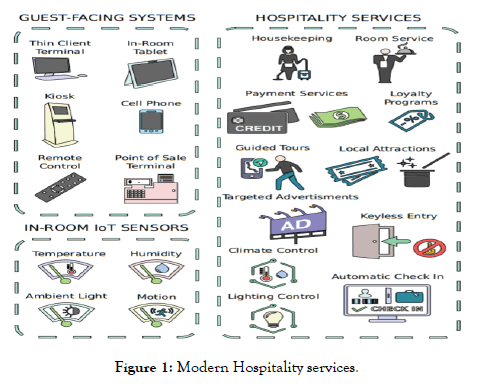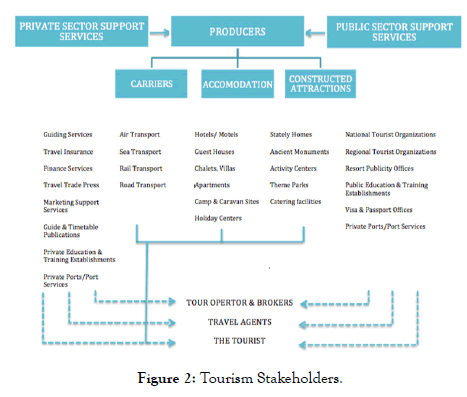Journal of Tourism & Hospitality
Open Access
ISSN: 2167-0269
ISSN: 2167-0269
Review Article - (2020)Volume 9, Issue 4
Tourism destination attractiveness is the main concept that attracts tourists` to destinations based on tourists perceived value of the destination and its attractions. However, despite this, Ghana, generally andparticularly the West Gonja District (WGD) with iconic and great attractions has not been able to package itself well to attract and give tourists` the best experience. Therefore, the study explored the demand and supply elements of tourism destination attractiveness and sort answers to how those elements have promoted the district`s attractiveness. Using a mixed-method research approach and both probability and non-probability sampling techniques, primary and secondary data were collected and analyzed. The study revealed that the West Gonja district is an attractive tourists` destination perceived as peaceful and safe with the majority of its supply elements deemed satisfactory. The study, therefore, recommends that the facility management, the Mole National Park, hotel and hospitality industry, and local community prioritize the tourism industryand work together to improve and coordinate tourism supply and demand elements to enhance the attractiveness of the district as a tourists` destination.
Innovation; Trends; Hospitality and travel industry
Hospitality and travel industry are important around the world such as providing entertainment/leisure, meeting/conference and Visiting Friends and Relatives (VFR) [1]. It also offers a range of complementary services including (accommodation, food and drinks, transportation, sightseer attraction, and leisure services), that enhance the happiness and comfort of their Customer/ Tourist [2,3]. When Tourists make use of services moreover contribute directly to the local financial system [4]. In recent many years, new trends and innovation have taken place in hospitality and travel industry like (Manmade Resources for Tourism, Symbiotic Tourism and Event Based Tourism VFR tourism) [5]. Aim of this review paper is to modulate latest trends in the industry to showcase with example, so in future many more entrepreneur build their career in this sector and fruitful benefit can be enjoyed by Domestic and international Guest/tourist [6]. All Information is gathering from various sources like paper and online sources, which have given me platform to showcase till date up gradation in this Industry (Figure 1).

Figure 1: Modern Hospitality services.
Objectives of the study:
• To know latest trends in hospitality and travel industry.
• Promote next-generation smart hotel in India.
• Promote India as a cruise destination.
• Influence of social media and mobile app.
• Encourage entrepreneur ideas to make it better future for tourism (Rubtzov et al., 2019) [7].
From the most recent years, the Hospitality and travel industry has seen significant changes. We can witness this by looking at different magazines; publish opportunities, papers, and collaborations. Because tourism is a demanding industry, it is important to understand the impact of innovation and technology on customer deeds.
How does online review play an important role in terms of selecting services provider? (e.g., accommodation, restaurants, transportation and attractions) [8].
The Simple Answer is “Word-of-Mouth”(WOM) now electronic forums social networking websites or travel-related information. Those are not only a useful co-creation tool for other tourists but also a crucial source of marketing information about tourism experiences for the service providers and create a unique travel experience for upcoming tourist too (Figure 2).

Figure 2: Tourism Stakeholders.
It works like a bridge between customers and service providers. As of now, it’s not compulsory to buy/rent the service/product. This information can be retrieved from feedback/experience from social network sources. Yes, we can also get and spread the right information all over the world in a few seconds.
I've used a mix of confidential and transparent tests.This page. I read papers that are scattered in the same way as paper articles on comparison lines and analyzed the situation. In addition, I have used macroeconomic models for including the effects this good will have on you assists the movement and recovery business administrative workplaces in India. Slowly unconfirmed tests I have used various sources what's going on, the details of the auxiliary collections to be made charts and statistics. Different considerations were used and paper from direct sources.
Based on empirical data and literature reviews, many conclusions can be drawn. Social media status represents an ongoing trend where hospitality is a lot to gain, but we must always be careful not to misuse Medium.
Its structure, product, management, and marketing have grown in number and diversity throughout the life-cycle of these years, as well as mobile phones that are more limited than a human-computer. Entered the moon in 1969. In that same year in 2002, when the hotel chains were working on international operations and product development, they had not fully developed the world's computer systems to manage their operations; however, Today smart phones are used for booking all over the world( Accommodation, Leisure, so on ), while sitting at home/workplace.
At the beginning of the 21 century, Hoteliers and restaurateurs have no experience to run business, but the current scenario has changed Owner/Student/Professional are increasing University degrees and will be eligible to handle different areas including finance, marketing, and human resources.
However, many problems seem to persist. Staff turnover and retention of new staff in Industry.
If you see many different industries working around the clock 24*7 and 365 days. The growth of the Internet and information communication technologies transfers problems experience in the hospitality industry to other industries.
Researchers are responding to these industry challenges and with education researchers being the only thing they use as speculators, many parts of the world are beginning to impact student recruitment. Universities grow by comparing themselves to using metrics, and the "quality" of research becomes monetary in one sense of the word as they, in particular, tend to attract graduate and graduate students. While the hotel industry has its own websites, as well as universities, universities are also looking to deliver courses and research without the printed word. MOOCs (massive open online courses) However, there are benefits. As the industry changes, so do the challenges for researchers to grow more interesting and the analytical approaches become more challenging.
Citation: Jagjit Singh (2020) Global Trends in Hospitality Industry. J Tourism Hospit 9:437. doi: 10.35248/2167-0269.20.9.437
Received: 04-Mar-2020 Accepted: 20-Jul-2020 Published: 27-Jul-2020 , DOI: 10.35248/2167-0269.20.9.437
Copyright: © Singh J. This is an open-access article distributed under the terms of the Creative Commons Attribution License, which permits unrestricted use, distribution, and reproduction in any medium, provided the original author and source are credited.